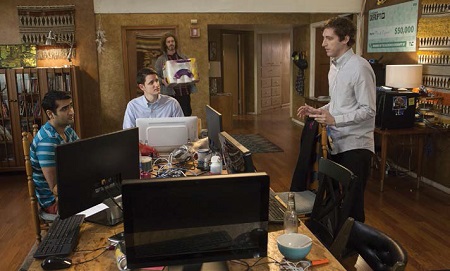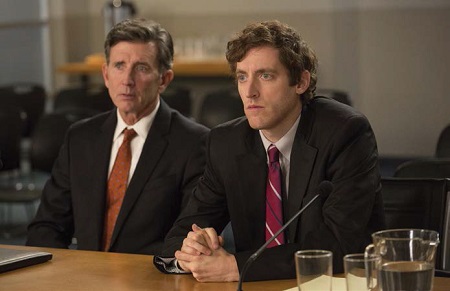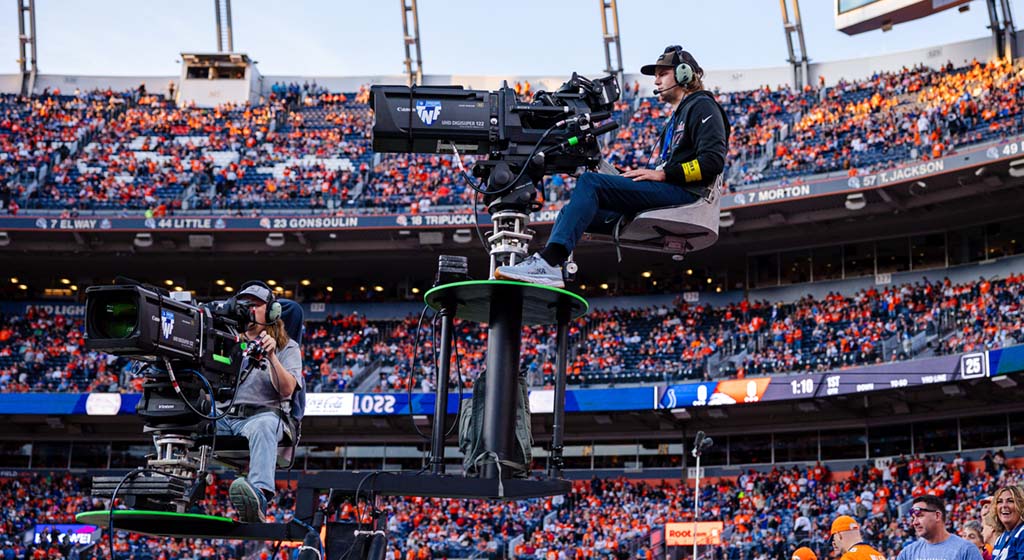Editing Calamity Begets Emmy for Merken
LOS ANGELES—Brian Merken, A.C.E., received the Emmy statuette on Sept. 12 for “Outstanding Single-Camera Picture Editing For A Comedy Series” for the episode “Two Days of the Condor” for HBO’s hit “Silicon Valley.” He recalled it as the payoff for the greatest gamble he ever took.
“Don’t tell my daughter,” Merken laughed, “but I quit college halfway through. I left Santa Monica City College just as I was beginning their film school track when I landed a production assistant gig. My film school turned out to be all the editors and production people I would meet on the job.”
Merken actually got the editing bug from a fourth grade teacher whose husband, Herbert Neil Travis, won an Oscar for cutting “Dances with Wolves.” A neighbor down the street, Barry Gold, who was editing “Pacific Blue” for the USA Network, introduced Merken to the Avid Media composer during off hours, got him on board as a production assistant, and helped him get into the Editors’ Guild.
Merken’s first assistant editor’s spot was on “Malcolm in the Middle,” working under Steve Welch. “A lot of my own editing style was learned from Steve,” he said. “He was one of the fastest guys on the Avid I’ve ever seen. It was very fortunate that I was able to work continuously for the first 12 years of my career moving from ‘Pacific Blue’ to ‘Malcolm.’”

(L TO R): Kumail Nanjiani, Zach Woods, TJ Miller and Thomas Middleditch in the “Silicon Valley” episode “Two Days of the Condor”GOING SOLO
Merken got his first solo editor’s credit on the short-lived “In the Motherhood,” and went on to work on a few other primetime footnotes, but it’s the geek-hip HBO comedy “Silicon Valley” that has given him the chance to really let his editing chops shine.
Merken gave us a glimpse of his work schedule on the “Two Days of the Condor” episode that won him the golden statuette. It was written and directed by Alec Berg.
“I like to watch all the dailies myself,” Merken began, “but it is handy for troubleshooting that my excellent assistant, Brian Bautista, logs everything into the Avid’s ScriptSync (aka Scriptor) function. We have three to four days to complete our editor’s cut, then another three or four to work with the director. Fortunately, during the whole last season of ‘Silicon Valley’ directors Alec Berg and Mike Judge were our show runners so they were in town and always busy on the set. Once an episode wrapped, we’d hit the ground running to lock the final version.”
As Merken described it, the plot was more linear than most of the shows, so “everything had to work as one. That meant I didn’t have the usual B plot that I could cut to when I needed to re-orient the structure.”
Essentially, the “Condor” episode’s storyline has to do with a bunch of young and eager code writers living in a startup incubator of a crash pad run by entrepreneur Erlich Bachman (T. J. Miller). One of them, Richard Hendricks (Thomas Middleditch) who works at a large Internet company called Hooli, developed a rad app named Pied Piper that contains a killer data compression algorithm. Hooli wants it, and has taken Hendricks before binding arbitration claiming he wrote Pied Piper using their equipment.
At first the judge seems to rule against Hendricks and the upstart coders, so Hendricks covertly texts his compadres to delete Pied Piper from their servers to keep it out of Hooli’s greedy mitts. But then the judge unexpectedly reverses himself on a technicality, and Hendricks has to scramble to save his software.
(What does all this have to do with a Condor? You’ll have to watch the episode on iTunes to find out.)

Matt McCoy (L), and Thomas Middleditch from the “Silicon Valley” episode “Two Days of the Condor”ONE CALAMITY AFTER ANOTHER
It’s that scramble to prevent the erasure of Pied Piper that builds the climax of the episode. Right after Hendricks hears the judge’s reversal, he knows he has to stop his friends from wiping Pied Piper from the servers, and what follows could be called “throwback” comedy. Just as the Steampunk movement mocks modern technology with a centuries-old aesthetic, the writing, editing and acting in this sequence brings Mack Sennett-style film construction into the digital age.
First Hendricks’ cellphone battery dies. Out of contact, he races for his car. But he drops his car keys and accidently kicks them down a sewer drain. No problem— he grabs the phone in a nearby coffee boutique only to remember that the number of the incubator pad exists only on speed dial on his dead phone. Then he dashes onto a city bus, grabs the driver’s cellphone and emails an urgent “Don’t Delete” message— but its unrecognized sender address promptly gets the message dumped into a spam folder.
Still, all is not lost because the goofballs back at the house have decided to have one last beer before deleting Pied Piper. But it’s a wheat beer, which of course necessitates finding a lemon before they can properly consume it. The problem is the lemon has to be cut from their neighbor’s tree. And then… you get the point. One calamity after another delays sending the “Don’t Delete” message while its intended recipients stumble over themselves until just as Hendricks gets to the front door, they hit the “Erase” button.
Fortunately for them, and the future of the series, the software deletion routine they had written fails and Pied Piper is preserved. But the accelerating energy of the intercut travails between Hendricks desperately trying to prevent the deletion and his buddies being incapable of actually pulling it off produces an energy epitomizing the dynamism of high bandwidth editing.
“The only segment we moved around in the edit bay is the second time the guys go outside to pick a lemon from their neighbor’s tree,” Merken said. “We needed one more jump to extend the checkerboard between Hendricks trying to get home and his friends dallying over sending their beloved Pied Piper into ‘cyber eternity,’ so we worked the sequence into having them go for a second lemon to improve the comedic timing.”
As is often the case, a lot of Merken’s editing comes from instincts gained from years sitting at an edit console. But I noticed a continuity in his cutaways where each time he spliced in a reaction shot, the person was seen to be responding directly to the character addressing him.
“I like to keep the flow of energy circling around the room,” Merken said. “I’m sure I learned a lot of this from the editor who was my most appreciated mentor, Steve Welch.”
It looks like that gamble to drop out of school paid off pretty well for Merken. Just don’t tell his daughter.
Jay Ankeney is a freelance editor and post-production consultant based in Los Angeles. Write him atJayAnkeney@mac.com.
Get the TV Tech Newsletter
The professional video industry's #1 source for news, trends and product and tech information. Sign up below.
